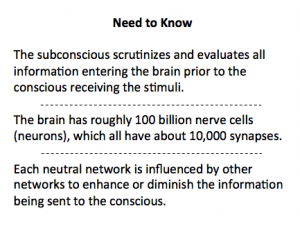Your brain: How “committees” on terrorism, concerts and weddings guide you
September 1, 2015 ~ Written by: W.B. “Bud” Kirchner
 “The brain – that’s my second most favorite organ” – Woody Allen
“The brain – that’s my second most favorite organ” – Woody Allen
After dozens of posts, I feel as though I have been remiss – so many references to the brain (Hell, the site is named after it!) but no commentary on the brain itself. In any event – here is a schema I offer you for the brain.
Do you really need to know this?
You better. After all, billions of committee members each with more than ten thousand hands are reaching out to influence your every thought!
Let me explain.
The brain has about 100 billion nerve cells (neurons). Each nerve cell has about 10,000 synapses (connections to other neurons). Signals enter the neuron until they reach a certain threshold and then the neuron sends an action potential thus creating an electrical signal. Incidentally, when you learn something these synapses become more efficient – think neuroplasticity.
For the non-luddites (i.e. technically savvy) in the audience – think of it as an enormous parallel information processing system.
The brain: where terrorism, concerts and weddings meet at the same time
One of my favorite (and easiest to understand) metaphors  for the way our neural network functions – i.e. the dialogue between conscious and subconscious around decisions, memories etc. – appears in a book I came across from 2008 titled “On Being Certain” by Robert Burton.
for the way our neural network functions – i.e. the dialogue between conscious and subconscious around decisions, memories etc. – appears in a book I came across from 2008 titled “On Being Certain” by Robert Burton.
The following is the essence of his description:
A bright light is flashed in your eyes. But, before an exact reproduction of the flash makes it to your conscious – it goes to the subconscious.
At subconscious level it is “scrutinized, evaluated and discussed by a screening committee representing all of your biological tendencies and past experiences.”
This review happens independent of the conscious part of the brain.
As the metaphor continues – each committee member represents an independent neural connection (memories). So you have groups like:
- Short Circuit Flash Childhood Memory Committee
- Terrorism General Alertness Committee
- Rock Concert Committee
- Genetic Predisposition to be Scared by Bright Lights Committee
In the metaphor, each committee has one number, one vote review of the situation (likely weighted by the intensity of the flash) to decide next steps – ranging from disregard to flight to fight – to send to the conscious part of the brain.
In this case, all members vote “yes” except for the rock concert because a ‘flash’ is no big deal if you have been to many concerts. That message is sent to the conscious part of the brain, which goes on high alert until you realize “you are at a wedding and everyone is taking pictures of the bride.”
The (combined) brains direction to the body – “Don’t be so anxious.”
Your brain makes the bed you lie in
In closing, while each committee member represents a neural network, each network can be influenced by other networks. They might enhance or diminish each other. So – as with a man no neural network is an island.
Just to tie this and the previous scientific description together: in the metaphor, the implication is that billions of committee members, each with more than ten thousand hands reaching out, are trying to influence (by reinforcement or rejection) other committee members.
“The unfortunate thing about this world is that good habits are so much easier to give up than bad ones.” ~ Somerset Maugham
The final point that Burton makes here centers on the idea that repeated signals across a neuron network behave like a stream creating a ‘bed’ in which it is more and more difficult to flow outside of. You wonder why habits are hard to break? You may remember my phrase from one of my earliest posts – “neurons that fire together wire together.”
So what say you? Now that you know how neurons work – billions of committees and thousands of hands reaching out – do you think those hands are working for you or against you? And does your answer mean you are half-full or half-empty person?
Incidentally, anyone who wants more insights than I am presenting on this topic and who think they learn new things most efficiently via metaphors (it’s a trick: we all learn best by metaphors), Burton’s book is worth a read (with the caveat it is seven years old so not everything he writes has stood the test of time).
And one more thing worth remembering, his book has another great metaphor starting on page 128. I’m sure I only need to tell you once because the metaphor is, of course, about remembering.
About the Author: W.B. “Bud” Kirchner is a serial entrepreneur and philanthropist with more than 50 years of business success. He is not a scientist or an academic but he does have a diversified exposure to neuroscience, psychology and related cognitive sciences. Generally speaking, the ideas he expresses here are business-angled expansions of other people’s ideas, so when possible, he will link to the original reference.
